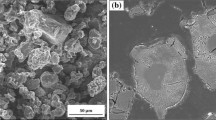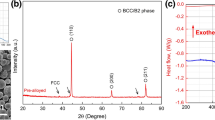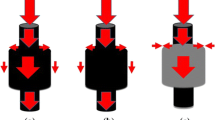Abstract
In this study, nanostructured Al 5083 powders, which were prepared via cryomilling, were consolidated using spark plasma sintering (SPS). The influence of processing conditions, e.g., the loading mode, starting microstructure (i.e., atomized vs cryomilled powders), sintering pressure, sintering temperature, and powder particle size on the consolidation response and associated mechanical properties were studied. Additionally, the mechanisms that govern densification during SPS were discussed also. The results reported herein suggest that the morphology and microstructure of the cryomilled powder resulted in an enhanced densification rate compared with that of atomized powder. The pressure-loading mode had a significant effect on the mechanical properties of the samples consolidated by SPS. The consolidated compact revealed differences in mechanical response when tested along the SPS loading axis and radial directions. Higher sintering pressures improved both the strength and ductility of the samples. The influence of grain size on diffusion was considered on the basis of available diffusion equations, and the results show that densification was attributed primarily to a plastic flow mechanism during the loading pressure period. Once the final pressure was applied, power law creep became the dominant densification mechanism. Higher sintering temperature improved the ductility of the consolidated compact at the expense of strength, whereas samples sintered at lower temperature exhibited brittle behavior. Finally, densification rate was found to be inversely proportional to the particle size.














Similar content being viewed by others
References
K. Lu: Int. Mater. Rev., 2008, vol. 53, pp. 21-38.
Z.A. Munir, U. Anselmi-Tamburini, and M. Ohyanagi: J. Mater. Sci., 2006, vol. 41, pp. 763-77.
A. Zuniga, L. Ajdelsztajn, and E.J. Lavernia: Metall. Mater. Trans. A, 2006, vol. 37A, pp. 1343-52.
A.P. Newbery, S.R. Nutt, and E.J. Lavernia: JOM, 2006, vol. 58, pp. 56-61.
J.R. Davis: ASM Specialty Handbook—Aluminum and Aluminu Alloys, ASM International, Materials Park, OH, 1994, pp. 675-76.
W.F. Hosford: Mechanical Behavior of Materials, Cambridge University Press, Cambridge, UK, 2005, pp. 151-52.
M. Zadra, F. Casari, L. Girardini, and A. Molinari: Powder Metall., 2007, vol. 50, pp. 40-45.
F. Guillard, A. Allemand, J.D. Lulewicz, and J. Galy: J. Eur. Ceram. Soc., 2007, vol. 27, pp. 2725-28.
S.J. Cho and K.J. Yoon: J. Am. Ceram. Soc., 1998, vol. 81, pp. 2458-60.
X.Y. Song, X.M. Liu, and J.X. Zhang: J. Am. Ceram. Soc., 2006, vol. 89, pp. 494-500.
M.A. Meyers and K.K. Chawla: Mechanical Behavior of Materials, Prentice Hall, Upper Saddle River, NJ, 1999, pp. 70-71.
ASM: Metals Handbook, American Society for Metals, Materials Park, OH, 1990, p. 212.
J.M. Zheng and P.F. Johnson: J. Am. Ceram. Soc., 1993, vol. 76, pp. 2760-68.
Q. Jiang, S.H. Zhang, and J.C. Li: Solid State Commun., 2004, vol. 130, pp. 581-84.
R.M. German: Sintering Theory and Practice, Wiley, New York, NY, 1996, pp. 313-39.
A.S. Helle, K.E. Easterling, and M.F. Ashby: Acta Metall., 1985, vol. 33, pp. 2163-74.
R.L. Coble: J. Appl. Phys., 1970, vol. 41, pp. 4798-4807.
D.S. Wilkinson and M.F. Ashby: Sintering and Catalysis, Ed. G.C. Kuczynski, Plenum Press, New York, 1975, pp. 473–92.
D.S. Wilkinson and M.F. Ashby: Acta Metall., 1975, vol. 23, pp. 1277-85.
J. Zhao, J.E. Garay, U. Anselmi-Tamburini, and Z.A. Munir: J. Appl. Phys., 2007, vol. 102, pp. 114902-07.
U. Anselmi-Tamburini, J.E. Garay, and Z.A. Munir: Mater. Sci. Eng. A, 2005, vol. 407, pp. 24-30.
E.J. Lavernia, B.Q. Han, and J.M. Schoenung: Mater. Sci. Eng. A, 2008, vol. 493, pp. 207-14.
I. Roy, M. Chauhan, E.J. Lavernia, and F.A. Mohamed: Metall. Mater. Trans. A, 2006, vol. 37A, pp. 721-30.
F. Zhou, X.Z. Liao, Y.T. Zhu, S. Dallek, and E.J. Lavernia: Acta Mater., 2003, vol. 51, pp. 2777-91.
T.T. Sasaki, T. Ohkubo, and K. Hono: Acta Mater., 2009, vol. 57, pp. 3529-38.
B. Sirinivasarao, K. Oh-Ishi, T. Ohkubo, and K. Hono: Acta Mater., 2009, vol. 57, pp. 3277-86.
Z.Z. Fang and H. Wang: Int. Mater. Rev., 2008, vol. 53, pp. 326-52.
J.P. Smith and G.L. Messing: J. Am. Ceram. Soc, 1984, vol. 67, pp. 238-42.
Y. Li, W. Liu, V. Ortalan, W.F. Li, Z. Zhang, R. Vogt, N.D. Browning, E.J. Lavernia, and J.M. Schoenung: Acta Mater., 2010, vol. 58, pp. 1732-40.
H.J. Frost and M.F. Ashby: Deformation-Mechanism Maps, The Plasticility and Creep of Metals and Ceramics, Pergamon Press, New York, 1982, pp. 20-29.
P.D. Desai: Int. J. Thermophys., 1987, vol. 8, pp. 621-38.
E. Arzt, M.F. Ashby, and K.E. Easterling: Metall. Trans. Phys. Metall. Mater. Sci., 1983, vol. 14, pp. 211-21.
Acknowledgments
This article is based on work supported by the U.S. Army TACOM-ARDEC under Contract No. W05QKN-09-C-118 and the Office of Naval Research with Grant No. N00014-07-1-0745. Part of D. Liu’s work is also supported by Grant No. BS2009CL043 from the Young Scientist Foundation of Shandong Province, China.
Author information
Authors and Affiliations
Corresponding author
Additional information
Manuscript submitted March 4, 2011.
Appendices
APPENDIX A. Parameters Used in this Paper
Table AI. Parameters Used in this Paper
Material Property | Aluminum | Reference |
|---|---|---|
Crystallographic and thermal data | ||
Atomic volume Ω (m3) | 1.66 × 10−29 | |
Burgers vector b (m) | 2.86 × 10−10 | |
Melting temperature T M (K) | 933 | |
Modulus | ||
Shear modulus at 300 K (27 °C), U 0 (MPa) | 2.54 × 104 | |
Temperature dependence of modulus, \( \frac{{T_{M} dU}}{{U_{0} dt}} \) | –0.5 | |
Lattice diffusion | ||
Preexponential, D 0V (m2/s) | 1.7 × 10−4 | |
Activation energy, Q V (kJ/mol) | 142 | |
Boundary diffusion | ||
Preexponential, δD 0b (m2/s) | 5.0 × 10−14 | |
Activation energy, Q b (kJ/mol) | 84 | |
Power-law creep | ||
Exponent n | 4.4 | |
Dorn constant A | 3.4 × 106 | |
Applied load P A (MPa) | 50 | |
Radius of particle, B (μm) | 10 | |
Fractional green density ρg | 0.64 | |
Yield stress σ y of Al 5083 at 673 K (400 °C) (MPa)* | 24 | |
Diameter of the sample ϕ (mm) | 20 | |
Electric current flowing through the sample I s (A) | 800 | |
Radius of the particle r p (μm) | 10 | |
Specific heat of the material C v (J/(kg K)) | 900 | |
Mass density of the particle ρ m (g/cm3) | 2.66 | |
Electric resistivity of the material ρ e (nΩ m) | 59.5 | |
A duration of the pulsed current Δt (ms) | 2.7 × 12 = 32.4 | |
Bulk melting entropy S vib (J mol−1 K−1) | 42.931 | |
Radius of spherical nanocyrstal r (nm) | 20 | |
Atomic diameter h (nm) | 0.286 | |
\( {\text{U}} = {\text{U}}_{0} [1 + \frac{{({{\rm T}} - 300)}}{{{{\rm T}}_{M} }}\frac{{{{\rm T}}_{M} dU}}{{{{\rm U}}_{0} dt}}] \) | ||
\( D_{V} = D_{0V} { \exp }( - \frac{{Q_{V} }}{\text{RT}}),\,\delta D_{b} = D_{0b} { \exp }( - \frac{{Q_{b} }}{\text{RT}}) \) | ||
\( P = \frac{{P_{A} (1 - \rho_{g} )}}{{\rho^{2} (\rho - \rho_{g} )}} + \frac{{2\gamma_{SV} }}{{r_{pore} }} - \frac{{(1 - \rho_{c} )\rho }}{{(1 - \rho )\rho_{c} }}P_{0} \) | ||
\( r_{\text{pore}} = B(\frac{1 - \rho }{6})^{1/3} \) is the pore radius, P 0 is the outgassing pressure, and ρ c is the density at which pores close |
APPENDIX B. Calculation of the Theoretical Density of Al 5083 Consolidated by SPS
The O atoms exist in the form of Al2O3. So the content of alumina can be calculated by:
The N atoms exist in the form of interstitial atoms or nitride, AlN. The content of the former is about 0.1 wt pct and the latter is 0.42 wt pct.[29] Consequently, the percentage of AlN can be estimated by:
The density of the sample is:
Table BI. Composition of the Consolidated Al 5083
Elements | Al | Mg | Mn | Fe | O | C | N | H |
|---|---|---|---|---|---|---|---|---|
wt pct | bal | 4.5 | 0.57 | 0.25 | 0.56 | 0.2 | 0.52 | 0.02 |
Rights and permissions
About this article
Cite this article
Liu, D., Xiong, Y., Topping, T.D. et al. Spark Plasma Sintering of Cryomilled Nanocrystalline Al Alloy - Part II: Influence of Processing Conditions on Densification and Properties. Metall Mater Trans A 43, 340–350 (2012). https://doi.org/10.1007/s11661-011-0841-6
Published:
Issue Date:
DOI: https://doi.org/10.1007/s11661-011-0841-6




